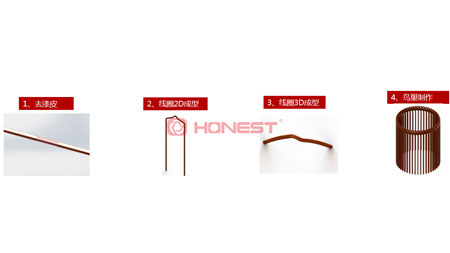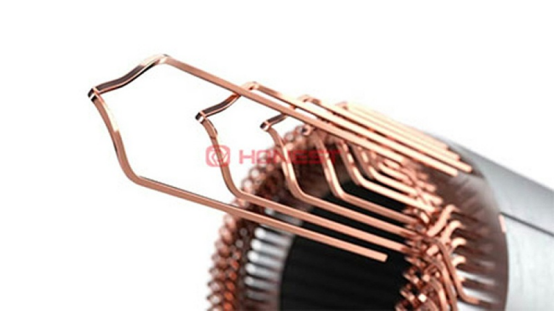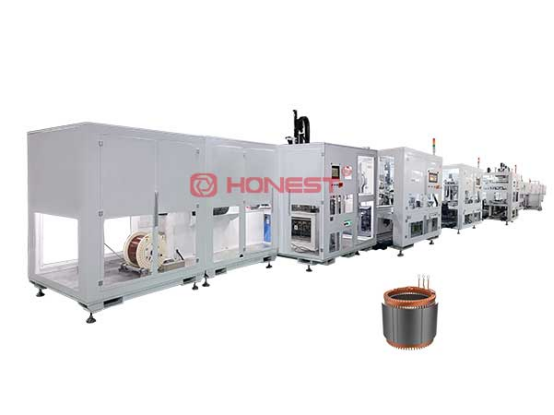
News Center
The Key Role of Bending in Hairpin Stator Manufacturing
Published on.
2025-08-08 10:31
Source
As global demand for high-efficiency, high-power-density motor continues to grow, hairpin motors have gained widespread adoption across EV drivetrains, household appliances, and industrial automation systems thanks to their superior performance.
Behind this performance lies a critical manufacturing step: the bending process of flat copper wires. By precisely controlling the shape and position of the conductors, the bending process enables tight and uniform winding placement, significantly improving slot fill rate and overall motor efficiency.
However, this is far more than just a simple “bend.” The process plays a vital role across several core aspects of motor performance:
Achieving Compact End Forming:
Precision bending ensures uniform height and neat alignment of all stator winding end turns, effectively reducing the motor’s axial dimensions. This contributes to consistent stator assembly and supports the trend toward motor miniaturization and lightweight design—critical for applications with limited space, such as electric vehicles and portable equipment.

Ensuring Electrical Connection Reliability:
Accurate bending is essential to ensure precise alignment of the conductor ends for welding. Proper positioning enables sufficient contact surface area, which directly enhances the stability and reliability of electrical connections.
Maintaining Conductor Integrity:
A well-executed bending process must allow for controlled plastic deformation of the conductor while minimizing the risk of damage to the insulation coating. This includes avoiding scratches, dents, cracks, or excessive stretching that could compromise insulation performance.
The Rhythm Keeper of the Production Line:
The bending station functions as the "metronome" of the entire hairpin motor production line. Its speed, stability, and yield rate directly determine the line's takt time and overall operational efficiency.
However, in real-world production, the bending process often faces multiple challenges.
First, maintaining consistent bending angles and precise positioning requires exceptionally accurate control and repeatability from the equipment—placing high demands on both machinery and process technology.
Second, variations in conductor materials, sizes, and mechanical properties introduce additional complexity, as different wire types require tailored bending parameters and setups.
Improper bending can result in degraded electrical performance, physical damage to the conductor, and complications during stator assembly. These issues can ultimately lead to reduced motor efficiency, shortened service life, and frequent failures.
That’s why bending is not just a manufacturing step—it serves as a critical first line of defense in quality control.

To address the various manufacturing challenges in the bending process, automated equipment is becoming a critical enabler of both quality and efficiency.
By incorporating advanced servo drive systems, vision-guided positioning, and inline inspection capabilities, automation not only enhances bending precision and consistency but also enables real-time process monitoring and adaptive adjustments—ensuring high product quality throughout the production cycle.
HONEST’s self-developed Universal Wire Forming Machine plays a vital role in this process. Designed with an innovative “all-in-one forming” concept, the machine integrates multiple functions—including wire straightening, enamel removal, 2D bending, 3D forming, insertion into insulation cups, and post-stripping surface defect inspection—into a single automated unit.
With a forming accuracy of up to ±0.05mm, the machine enables a seamless transition from raw material to finished shape. This integrated design reduces intermediate steps, minimizes human error, shortens downtime, and significantly improves production efficiency and product consistency.

In summary, as hairpin motor continue to evolve toward higher performance and large-scale adoption, the bending process has transformed from a manufacturing challenge into a key technical highlight. It not only reflects the upper limits of process precision but also serves as a symbol of a manufacturer’s capability in quality control and intelligent production.
HONEST’s Universal Wire Forming Machine embodies this shift—offering an integrated, intelligent, and exact solution that breaks through traditional production barriers. It empowers manufacturers to achieve greater autonomy, efficiency, and consistency in hairpin motor stator production.
Looking ahead, as smart manufacturing technologies advance, the bending process for flat copper conductors will continue to evolve toward higher precision, greater flexibility, and enhanced automation. HONEST Automation is committed to leading this evolution and driving the industry toward a new era of high-quality, energy-efficient motor production.
If you are looking for efficient hairpin motor assembly equipment or have questions about hairpin motor manufacturing processes, please feel free to leave a message online or contact us via email.
Related News






